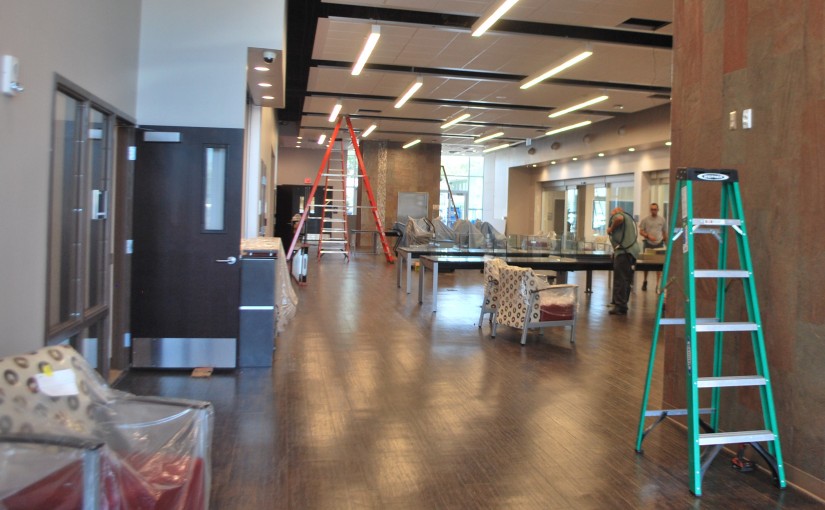
When it opens in August, the college’s new Midtown Center will have four times its current space.
BY ANDREW CAPLAN
NNB Student Reporter
ST. PETERSBURG – When St. Petersburg College’s sparkling new Midtown Center opens in August, the three-story, $15-million building will have six regular classrooms, three computer labs, two science labs, a career center, and a bookstore.
It will also have a challenge: Convince the people of Midtown that it wants to help revitalize the area, not dominate it.
The college has been on the city’s historic 22nd Street S – called “the Deuces” since it was the main street of the black community during the days of segregation – for more than a decade. But when it moves into its new building on 13th Avenue, it will have four times the space, far more students and a greatly expanded agenda.
The man in charge is the placid, well-spoken provost of the college’s Midtown and downtown campuses, Kevin Gordon.
Gordon, a native of St. Petersburg and graduate of Gibbs High School, is aware that some Midtown residents fear the college will gradually take over the neighborhood, pushing out some of the people and businesses that have called it home for many years.
But Gordon, 51, doesn’t want people to worry. “Our only agenda is community partnership,” he said.
The college will be a place where nearby residents can pursue a traditional two-year associate degree or certification in fields that require schooling for six months to a year, he said.
“I think at the end of the day, we’re really putting our money where our mouth is, in terms of really coming in and being a partner in the community,” he said. “Being able to address the issue of poverty is really important to me.”
In his mind, he said, Midtown “is a perfect place to be because a college degree is within walking distance if you want it. The hope is to be part of the stimulus for revitalization in Midtown.”
Facing uphill battles and changing views is nothing new for Gordon.
He came to the college in November 2011 from Gibbs High School, where in two and a half years he helped bring improvements in academic performance, student conduct and parental involvement.

The new building will complement the neighborhood’s recent resurgence, says Kevin Gordon, provost for the college’s Midtown and downtown campuses.
When he returned to his alma mater, he inherited the school district’s first F-rated high school. Nearly 1,200 of the school’s 1,900 students were underachievers on the state’s Florida Comprehensive Assessment Test, with proficiency scores of Level 1 or 2 out of 5, he said.
In his first year as principal, he said, the school identified and attempted to reverse the downward paths of about 400 students who were “severely off track” for graduation.
By his second year, Gordon said, the school began a “cohort model,” which allowed students to work with a guidance counselor and an assistant principal to address discipline and grade issues. Those who failed a course or needed further help were put in a credit recovery program right away, instead of waiting for their senior year, he said.
By the time he left, Gibbs’ state grade was a B, Gordon said.
“I was pretty satisfied with my performance as a principal,” he said. “But there’s always things that you wish you could’ve done that you didn’t get to.”
As a student at Gibbs years before, Gordon starred in track and basketball. He earned a bachelor’s in economics from Florida State and seemed headed for a future in computers, programming and information systems.
That changed when he volunteered at a Junior Achievement event designed to show high school students how to start a business, he said. He saw the need to help others, left his customer service job at a bank and got into teaching.
He joined the Pinellas County school system in 1987 as a teacher and became assistant principal at Clearwater High from 1996 to 2003. He was principal of John Hopkins Middle School and then High Point Elementary before moving to Gibbs in 2009.
Along the way, he received a master’s in educational leadership from Nova Southeastern University and a doctorate in educational leadership from the University of South Florida in Tampa.
St. Petersburg College has had a presence in Midtown since 2003, when it moved into a one-story, 10,000-square-foot building at 1048 22nd St. S.
In the years since then, the historic street has seen the stirrings of a comeback. A federal Job Corps training facility serving more than 200 students, a federal credit union and a shopping center have sprung up, and two long-shuttered icons of the segregation era – the Manhattan Casino and Mercy Hospital – have reopened with new entities inside.
On the northern flank of Midtown, meanwhile, an arts district has taken shape.
SPC’s new Midtown Center, on 3.7 acres at 1300 22nd St. S, would seem to complement the neighborhood’s resurgence. It is named for the late Douglas L. Jamerson Jr., a Midtown native who served as a state legislator and state commissioner of education.

The building, which bears the name of the late Douglas L. Jamerson Jr., a Midtown native and state legislator, will have two science labs.
But some have reservations about an institution that, to outsiders, can sometimes appear to be a bureaucratic behemoth.
A fiery protest erupted last year when the St. Petersburg Housing Authority invited the college to help run the African-American museum at 2240 Ninth Ave. S. The college quickly backed out.
A few months later, there were more misgivings when the college bought an empty gym building at 1201 22nd St. S.
Since then, the college has had meetings to get input from residents and community institutions. There are plans to use the gym as a community outreach center, Gordon said, and the new Midtown Center will have resources for the community on the first floor.
Registration for the fall semester opened in mid-June, and the building’s grand opening – with a ribbon cutting and tours – will be at 11 a.m. Aug. 1.
After that, Gordon said, he hopes to see hundreds of students and Midtown residents in the new building, working their way toward a brighter future.

